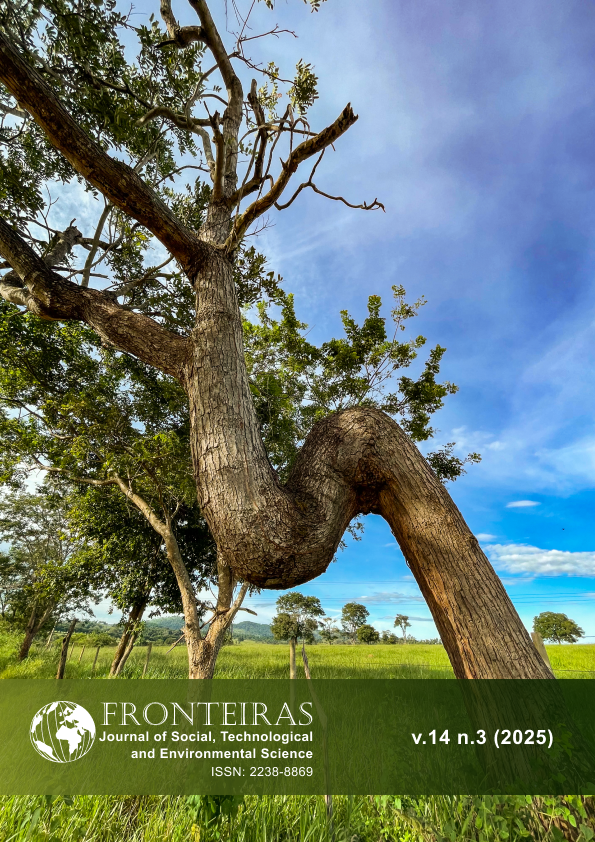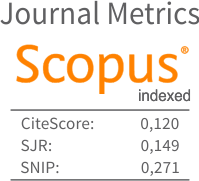Tolerance of Different Cowpea Cultivars Subjected to Irrigation with Saline Waters
DOI:
https://doi.org/10.21664/2238-8869.2025v14i3.7677Palavras-chave:
vigna unguiculata, salt stress, brs tumucumaque, brs guariba, brs imponenteResumo
Assuming that irrigation water salinity influences the growth and yield of cowpea plants, this study aimed to evaluate the effect of irrigation water salinity levels on the morphological and production traits of three cowpea cultivars. The experiment consisted of five salinity levels of irrigation water: (0.01, 1.41, 2.81, 4.21 and 5.61 dS m-1), three cultivars (BRS Tumucumaque, BRS Guariba, and BRS Imponente) and two periods of cultivation. A completely randomized block design was adopted in a split-split plot arrangement with four replications. The following parameters were evaluated: stem diameter (SD), plant height (PH), number of lateral branches (NLB), pod length (PL), number of grains per pod (NGP), ten-pod weight (TPW), number of pods per plant (NPP), 100-grain weight (GW) and grain yield. The data were subjected to analysis of variance by applying the F-test at 5% probability. Regression analysis was performed for the quantitative factor. There was a significant effect of the interaction between factors on all variables analyzed. The increase in irrigation water salinity reduces the morphological performance and yield of the cowpea cultivars BRS Tumucumaque, BRS Guariba, and BRS Imponente. However, the cultivar BRS Tumucumaque was the most tolerant to the negative effects resulting from increased irrigation water salinity.
Referências
Andrade JR, Junior SDOM, Silva PF, Barbosa JWS, Nascimento R, Sousa JS 2013. Crescimento inicial de genótipos de feijão caupi submetidos à diferentes níveis de água salina. Agropecuária Científica no Semiárido 9(4):36-40.
Aquino JPA, Bezerra AAC, Alcântara Neto F, Lima CJGS, Sousa RR 2017. Morphophysiological responses of cowpea genotypes to irrigation water salinity. Revista Caatinga, 30(4), 1001–1008. https://doi.org/10.1590/1983-21252017v30n421rc.
Assis Júnior JO, Lacerda CB, Silva FB, Silva FLB, Bezerra MA, Gheyi HR 2007. Produtividade do feijão-de-corda e acúmulo de sais no solo em função da fração de lixiviação e da salinidade da água de irrigação. Engenharia Agrícola, 27(3), 702–713. https://doi.org/10.1590/S0100-69162007000400013.
Ayers RS, Westcot DW 1999. The water quality in agriculture. 2nd. ed. Campina Grande: UFPB: Studies FAO Irrigation and Drainage Paper No. 29.
Bezerra AAC, Neves AC, Alcântara Neto F, Silva Júnior JV 2014. Morfofisiologia e produção de feijão-caupi, cultivar BRS Novaera, em função da densidade de plantas. Revista Caatinga, 27(4), 135–141.
Bezerra AAC, Alcântar Neto F, Neves AC, Maggioni K 2012. Comportamento morfoagronômico de feijão-caupi, cv. BRS Guariba, sob diferentes densidades de plantas. Revista de Ciências Agrárias, 55(3), 184–189. hhtp::/dx/doxdor:h10x4322:ocax2012x059.
Bezerra AKP, Lacerda CF, Hernandez FFF, Silva FB, Gheyi HR 2010. Rotação cultural feijão caupi/milho utilizando-se águas de salinidades diferentes. Ciência Rural, 40(5), 1075–1082. https://doi.org/10.1590/S0103-84782010000500012.
Brito KQD, Nascimento R, Santos JEA, Souza FG, Silva IAC 2015. Crescimento de genótipos de feijão-caupi irrigados com água salina. Revista Verde, 10(5), 16–21. https://doi.org/10.18378/rvads.v10i5.3622.
Cavalcante EDS, Freire Filho FR, Rocha MDM, Goes A, Ribeiro V, Silva KE 2014. BRS Tumucumaque: cultivar de feijão-caupi para o Amapá e outros estados do Brasil. Comunicado Técnico, 124, ISSN 1517-4077.
Dias NS, Blanco FF 2010. Efeitos dos sais no solo e na planta. In: Gheyi HR, Dias NS, Lacerda CF. (Eds.), Manejo da salinidade na agricultura: estudos básicos e aplicados 2. 1. ed. Fortaleza: INCTSal, pp. 129–141.
Foyer CH, Noctor G 2000. Oxygen processing in photosynthesis: regulation and signalling. New Phytologist, 146(3), 359–388. https://doi.org/10.1046/j.1469-8137.2000.00667.x.
Furtado GF, Sousa Junior JR, Xavier DA, Andrade EMG, Sousa JRM 2014. Componentes de produção do feijão vigna sob estresse salino e doses de nitrogênio. Revista Verde de Agroecologia e Desenvolvimento Sustentável, 8(5), 130–136.
Gogna M, Choudhary A, Mishra G, Kapoor R, Bhatla SC 2020. Changes in lipid composition in response to salt stress and its possible interaction with intracellular Na+-K+ ratio in sunflower (Helianthus annuus L.). Environmental and Experimental Botany, 178, 104147. https://doi.org/10.1016/j.envexpbot.2020.104147.
Gonçalves ICR, Araújo ASF, Nunes LAPL, Bezerra AAC, Melo WJ 2014. Heavy metals and yield of cowpea cultivated under composted tannery sludge amendment. Acta Scientiarum. Agronomy, 36(4), 443. https://doi.org/10.4025/actasciagron.v36i4.18094.
Hassani A, Azapagic A, Shokri N 2021. Global predictions of primary soil salinization under changing climate in the 21st Century. Nature Communications, 12(1), 1-17. https://doi.org/10.1038/s41467-021-26907-3.
Holanda JP, Amorim JRA 1997. Qualidade de água para irrigação. In: Gheyi HR, Queiroz JE, Medeiros JF (Eds.), Manejo e controle da salinidade na agricultura irrigada. Campina Grande: UFPB/SBEA, pp. 137–169.
Hossain MS 2019. Present scenario of global salt affected soils, its management and importance of salinity research. International Research Journal of Biological Sciences, 1(1), 1–3.
Lima CJGSS, Oliveira FA, Medeiros JF, Oliveira MKT, Almeida Júnior AB 2007. Resposta do feijão caupi a salinidade da água de irrigação. Revista Verde, 2(2), 79–86.
Lima JRS, Antonio ACD, Lira CABO, Souza ES, Silva IF 2011. Balanço de energia e evapotranspiração de feijão caupi sob condições de sequeiro. Revista Ciência Agronômica, 42(1), 65–74. https://doi.org/10.1590/S1806-66902011000100009.
Miranda RS, Souza FIL, Alves AF, Souza RR, Mesquita RO, Ribeiro MID, Santana-Filho G, Gomes-Filho E 2021. Salt-acclimation physiological mechanisms at the vegetative stage of cowpea genotypes in soils from a semiarid region. Journal of Soil Science and Plant Nutrition, 21(4), 3530–3543.
Munns R, Gilliham M 2015. Tansley insight: Salinity tolerance of crops – what is the cost? New Phytologist, 208, 668–673. https://doi.org/10.1111/nph.13519.
Neves ALR, Lacerda CF, Guimarães FVA, Hernandez FFF, Silva FB, Prisco JT, Gheyi HR 2009. Acumulação de biomassa e extração de nutrientes por plantas de feijão-de-corda irrigadas com água salina em diferentes estádios de desenvolvimento. Ciência Rural, 39, 758–765. https://doi.org/10.1590/S0103-84782009005000014.
Oliveira FDA, Oliveira MKT, Lima LA, Alves RC, Regis LRL, Santos ST 2017. Estresse salino e biorregulador vegetal em feijão-caupi. Irriga, 22(2), 314–329. https://doi.org/10.15809/irriga.2017v22
Oliveira FN, Torres SB, Benedito CP, Marinho JC 2013. Comportamento de três cultivares de maxixe sob condições salinas. Semina: Ciências Agrárias, 34(6), 2753. DOI: 10.5433/1679-0359.2013v34n6p2753.
Pereira EDED, Marinho AB, Ramos EG, Fernandes CND, Borges FRM, Adriano JNJ 2019. Saline stress effect on cowpea beans growth under biofertilizer correction. Bioscience Journal, 35(5), 1328–1338. https://doi.org/10.14393/BJ-v35n5a2019-42387.
Pessoa LG, Freire MBDS, Green CH, Miranda MF, José Filho CDA, Pessoa WR 2022. Assessment of soil salinity status under different land-use conditions in the semiarid region of Northeastern Brazil. Ecological Indicators, 141, 109139. https://doi.org/10.1016/j.ecolind.2022.109139.
Praxedes SSC, Ferreira Neto M, Loiola AT, Santos FJQ, Umbelino BF, Silva LDA, Moreira RCL, Melo AS, Lacerda CS, Fernandes PD, Dias NS, Sá FVDS 2022. Photosynthetic Responses, Growth, Production, and Tolerance of Traditional Varieties of Cowpea under Salt Stress. Plants, 11(14), 1863. https://doi.org/10.3390/plants11141863.
Prazeres SS, Lacerda CF, Barbosa FEL, Amorim AV, Araujo ICS, Cavalcante LF 2015. Crescimento e trocas gasosas de plantas de feijão-caupi sob irrigação salina e doses de potássio. Revista Agro@mbiente, 9(2), 111–118. https://doi.org/10.18227/1982-8470ragro.v9i2.2161.
Sá FVS, Ferreira Neto M, Lima YB, Paiva EP, Silva AC, Dias NS, Souza FM, Melo AS, Moreira RCL, Silva LA 2019. Phytomass accumulation and mineral composition of cowpea (Vigna unguiculata) under salt stress and phosphate fertilization. Australian Journal of Crop Science, 13(7), 1149–1154. doi: 10.21475/ajcs.19.13.07.p1662.
Sadeghipour O 2017. Amelioration of salinity tolerance in cowpea plants by seed treatment with methyl jasmonate. Legume Research, 40(6), 1100–1106. DOI: 10.18805/lr.v0i0.8394.
Santos AA, Silveira JAG, Bonifacio A, Rodrigues AC, Figueiredo MDVB 2018. Antioxidant response of cowpea co-inoculated with plant growth-promoting bacteria under salt stress. Brazilian Journal of Microbiology, 49(1), 513–521.
Sheikh-Mohamadi MH, Etemadi N, Aalifar M, Pessarakli M 2022. Salt stress triggers augmented levels of Na+, K+ and ROS alters salt-related gene expression in leaves and roots of tall wheatgrass (Agropyron elongatum). Plant Physiology and Biochemistry, 183, 9-22. https://doi.org/10.1016/j.plaphy.2022.04.022.
Silva Júnior JV, Bezerra AAC, Silva EM 2021. Crescimento e desenvolvimento de cultivares de feijão-caupi em função da salinidade da água de irrigação. Irriga, 26(2), 343-366. https://doi.org/10.15809/irriga.2021v26n2p343-366.
Silva FLB, Lacerda CF, Neves ALR, Sousa GG, Sousa CHC, Ferreira FJ 2013. Irrigação com águas salinas e uso de biofertilizante bovino nas trocas gasosas e produtividade de feijão-de-corda. Irriga, 18(2), 304–317. https://doi.org/10.15809/irriga.2013v18n2p304.
Silva FLB, Lacerda CF, Sousa GG, Neves ALR, Silva GL, Sousa CHC 2011. Interação entre salinidade e biofertilizante bovino na cultura do feijão-de-corda. Revista Brasileira de Engenharia Agrícola e Ambiental, 15(4), 383–389. https://doi.org/10.1590/S1415-43662011000400009.
Silveira JAG, Costa RCL, Viegas RA, Oliveira JTA, Figueiredo MVB 2003. N-compound accumulation and carbohydrate shortage on N2 fixation in drought-stressed and rewatered cowpea plants. Spanish Journal of Agricultural Research, 1(3), 65–75. https://doi.org/10.5424/sjar/2003013-36.
Sogoni A, Jimoh MO, Kambizi L, Laubscher CP 2021. The impact of salt stress on plant growth, mineral composition, and antioxidant activity in tetragonia decumbens mill.: An underutilized edible halophyte in South Africa. Horticulturae, 7(6), 140. https://doi.org/10.3390/horticulturae7060140.
Staff, Soil Survey 2014. Keys to soil taxonomy. United States Department of Agriculture: Washington, SD, USA.
Tagliaferre C, Guimarães DUG, Gonçalves LJ, Amorim CHF, Matsumoto SN, D´rêde LO 2018. Produtividade e tolerância do feijão caupi ao estresse salino. Irriga, 23(1), 168–179. https://doi.org/10.15809/irriga.2018v23n1p168.
Taiz L, Zeiger E 2013. Fisiologia Vegetal. 4a ed. Porto Alegre: ArtMed.
Tavares DS, Fernandes TEK, Rita YL, Rocha DC, Sant'Anna-Santos BF, Gomes MP 2021. Germinative metabolism and seedling growth of cowpea (Vigna unguiculata) under salt and osmotic stress. South African Journal of Botany, 139, 399-408. https://doi.org/10.1016/j.sajb.2021.03.019.
Teixeira PC, Donagemma GK, Fontana A, Teixeira W 2017. Manual de métodos de análise de solo. Brasília: Embrapa.
Wang H, Zheng C, Ning S, Cao C, Li K, Dang H, Wu Y, Zhang J. 2023. Impacts of long-term saline water irrigation on soil properties and crop yields under maize-wheat crop rotation. Agricultural Water Management, 286, 108383. https://doi.org/10.1016/j.agwat.2023.108383.
Win KT, Oo AZ 2015. Genotypic difference in salinity tolerance during early vegetative growth of cowpea (Vigna unguiculata L. Walp.) from Myanmar. Biocatalysis and Agricultural Biotechnology, 4(4), 449-455. https://doi.org/10.1016/j.bcab.2015.08.009.
Wu H 2018. Plant salt tolerance and Na+ sensing and transport. The Crop Journal, 6(3), 215–225. https://doi.org/10.1016/j.cj.2018.01.003.
Xiang D, Song Y, Wu Q, Ma C, Zhao J, Wan Y, Zhao G 2019. Relationship between stem characteristics and lodging resistance of Tartary buckwheat (Fagopyrum tataricum). Plant Production Science, 22(2), 202–210. https://doi.org/10.1080/1343943X.2019.1577143.
Downloads
Publicado
Como Citar
Edição
Seção
Licença
Copyright (c) 2025 José Valdenor Silva Júnior, Antônio Aécio de Carvalho Bezerra, Everaldo Moreira Silva, Wesley dos Santos Souza, Jenilton Gomes Cunha, Romário Martins Costa

Este trabalho está licenciado sob uma licença Creative Commons Attribution-NonCommercial 4.0 International License.
Esta revista oferece acesso livre imediato ao seu conteúdo, seguindo o princípio de que disponibilizar gratuitamente o conhecimento científico ao público proporciona maior democratização mundial do conhecimento.
A partir da publicação realizada na revista os autores possuem copyright e direitos de publicação de seus artigos sem restrições.
A Revista Fronteiras: Journal of Social, Technological and Environmental Science segue os preceitos legais da licença Creative Commons - Atribuição-NãoComercial 4.0 Internacional.


